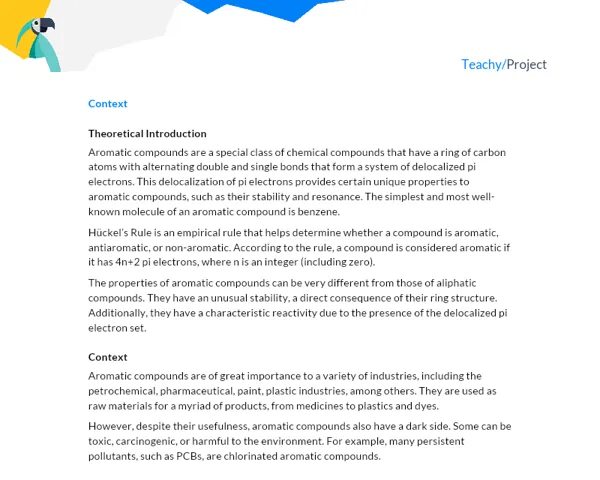Contextualization
The periodic table of elements is one of the fundamental pillars in the study of chemistry. It is a visual representation that organizes the chemical elements based on their physical and chemical properties. The elements are ordered in increasing atomic number, which is essentially the number of protons in the nucleus of an atom, and arranged in groups that share similar properties.
The periodic table we use today is known as the modern periodic table and was developed based on the work of many scientists throughout history. However, the contribution of the scientist Dmitri Mendeleev was fundamental, as he was the one who proposed an ordination of the chemical elements based on their properties, predicting the existence of elements that had not yet been discovered.
A modern periodic table contains more than 100 elements, each with its own set of properties. These properties can be divided into periodic properties (those that repeat in certain cycles as we move through the table) and non-periodic properties (those that do not present a cyclical pattern). The main periodic properties are: atomic radius, ionization energy, electron affinity and electronegativity.
Through the periodic table, we can predict the nature and behavior of unknown substances, perform chemical calculations and understand chemical reactions and interactions. In addition, the periodic table also serves as a vital tool for research in fields such as medicine, biology, physics, engineering and many others.
Healthcare professionals, for example, use knowledge about the periodic table to develop new medicines and treatments. In industry, chemists use this information to create new materials and substances. Even in our daily lives, the periodic table is present, whether in the composition of the food we eat, in the cleaning products we use, or in almost everything around us.
In carrying out this project, you will be able to use the following materials as a basis and for further study:
- Book: Atkins, P.; Jones, L. Principles of Chemistry: Questioning Life Modern and the Environment. 5th ed. Bookman, 2012.
- Video: YouTube Channel "Chemistry in Action", by Professor Paulo Valim.
- Website: Complete and Updated Periodic Table: History, Description and Research Lines.
Practical Activity
Activity Title: Periodic Property Game
Project Objective:
This project aims to provide students with an opportunity to explore, in a practical and playful way, the properties of chemical elements in the context of the periodic table. Through the creation of a game, students will deepen their understanding of the periodic and non-periodic properties of the elements.
Detailed Project Description:
Students, in groups of 3 to 5, must develop a board game with the theme of the periodic table. The game must be designed in such a way that, in order to advance, players need to correctly answer questions about the properties of chemical elements, or perform specific tasks based on these properties.
Required Materials:
- Cardboard or card stock for the base of the board
- Colored paper to decorate the board and create question cards
- Markers or colored pens
- Scissors, glue, tape
- Pieces for the players (can be made of modeling clay, for example)
- Dice (to determine the movement of the players)
Step-by-Step Instructions for Carrying out the Activity:
- Research: Students should begin their research on the properties of chemical elements, focusing mainly on periodic properties (atomic radius, ionization energy, electron affinity and electronegativity).
- Game Planning: After the research, students should discuss and plan how the game will be. They should define the rules, such as the questions, penalties and rewards, and how the properties of the elements will be addressed in the game.
- Board Construction: After defining the rules, students should build the game board. They can decorate the board with images and colors related to chemistry and the periodic table.
- Question Development: Next, students should develop the questions that will be used in the game. They should be based on the properties of the elements and need to be challenging enough to stimulate learning.
- Game Test: After the game is built, students should play at least one "test" to make sure everything works properly and the difficulty level is appropriate.
- Final Adjustments: Based on the test round, students should make final adjustments to the game, if necessary.
- Game Presentation: Finally, the groups will present their games to the class, explaining the rules and highlighting how the properties of the elements were incorporated into the game.
Project Deliverables and Complementation with the Written Document:
For each group, the project deliverables include the board game itself, along with a written report. In the report, students should include the following topics:
Introduction:
Students should introduce the theme of the periodic table, highlighting its relevance and applicability in the real world, and the objective of this project.
Development:
Students should describe in detail the step-by-step development of the project, presenting the theory used as the basis for creating the game, the rules of the game, how the properties of the elements were incorporated into the game and the results achieved. It is important that students present and discuss the results obtained during the test round, indicating possible adjustments made and justifying them.
Conclusion:
Students should conclude the work by summarizing their main points, highlighting what they learned in the process and the conclusions they drew from the project. They should reflect on the experience of working in a group and how completing this project contributed to their understanding of the properties of the elements in the periodic table.
Bibliography:
Students should indicate the sources they consulted for the development of the project, such as books, websites, videos, among others.
Each group will have one month to complete the project and each student should dedicate between five and ten hours of work. The project will be evaluated based on the degree of creativity, understanding of the theme and the overall quality of the board game and written report.

